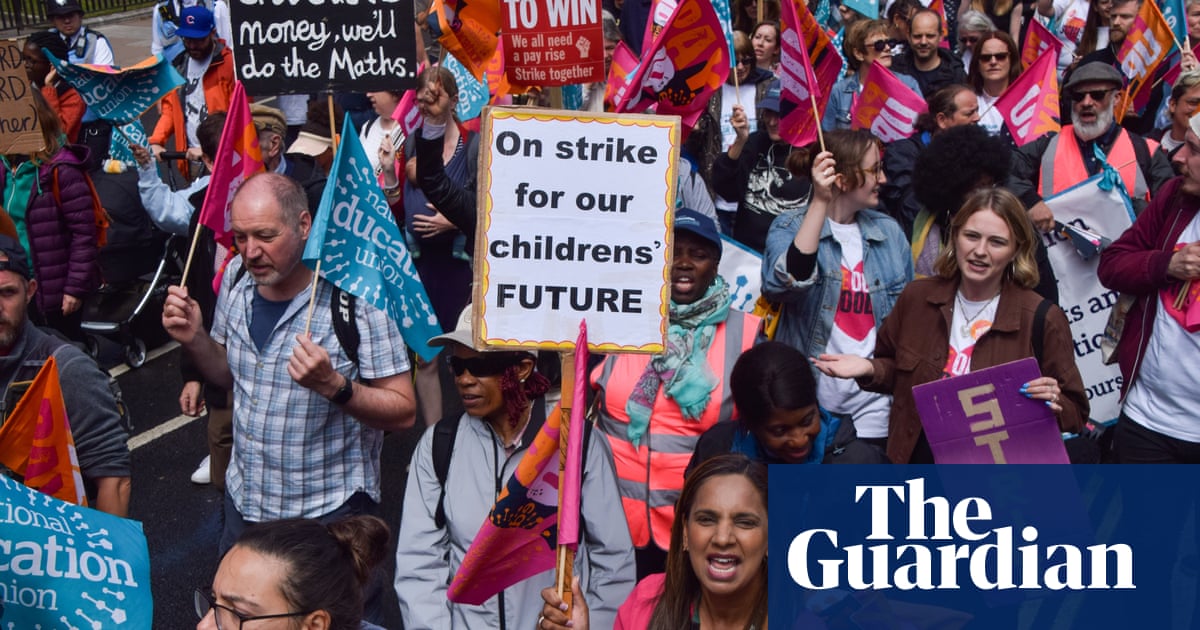
Attainment among seven-year-olds in England has fallen sharply across all subjects in the first set of tests since before the pandemic, with disadvantaged children’s results dropping even further behind, according to government data.
Results for this year’s key stage 1 (KS1) tests show a significant decline in attainment in reading, maths and, most dramatically, writing, in which the proportion of year 2 pupils reaching the expected standard declined by 11 percentage points.
In the year 1 phonics screening check, a key government measure of progress among five- and six-year-olds, 75% of pupils met the expected standard this year, down from 82% in 2019. The same check on year 2 pupils showed 87% achieved the required standard, down from 91%.
It is the first drop in attainment since the phonics check was introduced in 2012 and will ring alarm bells in the Department for Eduction (DfE), which has set itself an ambitious target of having 90% of children leaving primary school with the expected standard in reading, writing and maths by 2030.
The results, published on Thursday, reveal the impact of Covid disruption on the youngest schoolchildren, whose entire education has been overshadowed by the pandemic. They will add to concerns about the growing attainment gap between pupils from more affluent backgrounds and their more disadvantaged peers since the pandemic hit, and the effectiveness of the government’s education recovery programme.
The DfE data shows half of disadvantaged students (51%) reached the expected level for reading this year, down from 62% in 2019, while the drop in attainment among non-disadvantaged pupils was smaller, down from 78% to 72%.
In writing, just two out of five children (41%) from disadvantaged backgrounds reached the required standard, down from 55% in 2019, while for other pupils the proportion fell from 73% to 63%. Similarly, maths attainment among disadvantaged pupils fell the furthest, from 62% to 52%, compared with a drop from 79% to 73% for other pupils.
Jon Andrews, the head of analysis at the Education Policy Institute (EPI), said: “Not only has overall attainment declined but some of the country’s most vulnerable children are falling further behind their peers. We know that the disadvantage gap for 11-year-olds is now around the same level as it was in 2012, taking us back a decade.”
He added: “Today’s data for younger pupils highlight again the level of challenge in addressing that disparity. Only half of pupils from low-income backgrounds starting key stage 2 this year achieved the expected standard in each of reading and mathematics at the end of key stage 1, and just four in 10 pupils did so in writing.”
Earlier this year, results for the first KS2 Sats assessments since 2019 also showed a decline in attainment. Just 59% of 10- and 11-year-olds reached the DfE’s expected standards in literacy, writing and maths, the lowest rate since 2017 and below the 65% recorded in 2019. There was, however, a surprise improvement in reading, with 74% at or above the national standard, up from 73% in 2019.
There was no similar ray of sunshine in the KS1 results, with attainment down from 2019 across the board. In reading, 67% of pupils met the expected standard, down from 75% in 2019. In maths it decreased from 76% in 2019 to 68%, and similarly in science just 77% of pupils met the national standard, down from 82% in 2019.
Andrews said tackling the increasing inequality in the education system should be an urgent priority for the government. “Given the challenges that loom ahead, ministers must focus on adequately resourcing schools and implementing a cross-government child poverty strategy.”
Paul Whiteman, the general secretary of the National Association of Head Teachers, said: “The government has let down this cohort by not investing in their recovery. But it can still act now. Schools are currently under unprecedented financial pressure due to the cost of living [crisis], which is forcing cuts to teaching and support staff that directly impacts the most disadvantaged and high needs pupils.
“The government cannot sit back and let this second massive blow to disadvantaged pupils hit.”
The shadow education secretary, Bridget Phillipson, said: “The government’s own education recovery tsar’s warnings are coming true: that the pandemic risks doing permanent damage to children’s education because of the Conservatives’ failure to support properly pupils’ recovery.”
Meanwhile, on Thursday, a coalition of parents, unions and school and college leaders wrote to the prime minister, Liz Truss, and the education secretary, Kit Malthouse, about the crisis in school funding and reports of further “efficiencies” in public spending.
Twelve organisations signed the open letter, including the main teaching unions, as well as Unison, the National Governance Association for school governors, and Parentkind, which represents PTAs. They warn that current funding levels do not cover rising costs and there is “a very real risk” of decline in educational standards.
“The reality is that school and college spending has been cut to the bone over the past decade, there is no room for efficiencies, and a real-terms cut in funding will be catastrophic,” the letter says.
“If schools and colleges have to make further savings, this will inevitably mean reductions in teaching and support staff. This will result in larger class sizes, cuts to the curriculum and student support services, and cuts in extra-curricular provision, such as school trips and clubs.”
The letter went on: “Your government claims to be pursuing an agenda of economic growth but we fail to see how growth can be sustainable, and how our country can look forward to a secure and prosperous future, without sufficient investment in education.”
A DfE spokesperson said: “We know the pandemic impacted children’s learning and we are investing nearly £5bn, with over 2m high quality tutoring courses already started, to make sure children can catch up fast, and schools should continue to work with parents to make them aware of the additional support on offer.”











